How ACUVEX® Meets ASTM G90
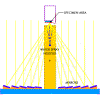 Each ACUVEX® contains ten specular – highly-reflective – mirrors
that focus sunlight onto an air-cooled specimen area as required by
ASTM G90. Specimens face the mirrors and are mounted upside down onto a
specimen target area. Specimen temperatures are maintained by a fan that blows
ambient air over the front and back specimen surfaces.
Each ACUVEX® contains ten specular – highly-reflective – mirrors
that focus sunlight onto an air-cooled specimen area as required by
ASTM G90. Specimens face the mirrors and are mounted upside down onto a
specimen target area. Specimen temperatures are maintained by a fan that blows
ambient air over the front and back specimen surfaces.
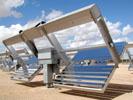 ACUVEX stands for Accurate Controlled Ultra Violet EXposure. Two
ACUVEX test machines are mounted onto a single tracker which
automatically rotates in azimuth (rotation) and elevation to keep
the specimen area in focus.
ACUVEX stands for Accurate Controlled Ultra Violet EXposure. Two
ACUVEX test machines are mounted onto a single tracker which
automatically rotates in azimuth (rotation) and elevation to keep
the specimen area in focus.
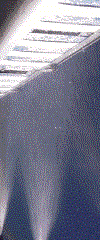 Specimens are mounted upside down onto a specimen target area facing the
mirrors. Compared to a southern Florida outdoor exposure,
ACUVEX specimens typically receive about 5 times more ultraviolet
radiation over a one year time period.
Specimens are mounted upside down onto a specimen target area facing the
mirrors. Compared to a southern Florida outdoor exposure,
ACUVEX specimens typically receive about 5 times more ultraviolet
radiation over a one year time period.
High purity water spray is used to simulate the effect of humid climates. This water must contain less than 1.0 ppm TDS (total dissolved solids) and less than 0.2 ppm Silica to be in compliance with ASTM G90, "Standard Practice for Performing Accelerated Outdoor Weathering Using Concentrated Natural Sunlight."
Four water spray cycles are available as shown in the table below:
| Spray Cycle | Description |
|---|---|
| Cycle 1* | 8-minute water sprays every hour during the day with three 8-minute water sprays during the night |
| Cycle 2* | No water sprays |
| Cycle 3* | 3 minute water sprays every 15 minutes during the night |
| AZTEST Extended | 8 minute water sprays every hour during the day with 3 minute water sprays every 15 minutes during the night |
*These cycles are listed in ASTM G90.
Specimens are typically flat with a maximum dimension of 13 cm (5 inches) along one edge. For larger specimens, please contact customer service. A typical specimen size would be 7.5 x 13 cm (3" x 5"), however, many sizes can be accommodated as long as one dimension does not exceed 13 cm (5 in). Typical specimen thickness would be 3 mm (1/8") or less, but thicker specimens can be accommodated with special mounting. Specimens are usually mounted unbacked, which allows both front and back surfaces to be cooled, but backed mounting can be used to provide higher specimen temperatures.
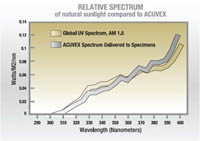 This graph depicts the RELATIVE spectrum of natural sunlight
compared to ACUVEX. When contrasted with Compared to other
accelerated weathering test methods, ACUVEX; – which
complies with ASTM G90 – provides the closest match to natural
sunlight in ultraviolet terms.
This graph depicts the RELATIVE spectrum of natural sunlight
compared to ACUVEX. When contrasted with Compared to other
accelerated weathering test methods, ACUVEX; – which
complies with ASTM G90 – provides the closest match to natural
sunlight in ultraviolet terms.
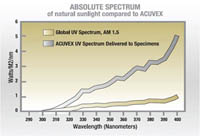 This graph portrays the ABSOLUTE spectrum of natural sunlight compared to
ACUVEX. With ACUVEX, radiation intensity at the specimen surface
is much greater than with natural sunlight exposure – providing
faster tests.
This graph portrays the ABSOLUTE spectrum of natural sunlight compared to
ACUVEX. With ACUVEX, radiation intensity at the specimen surface
is much greater than with natural sunlight exposure – providing
faster tests.
Learn about the Advanced Features of the ACUVEX®
Return to the ACUVEX® Home Page
